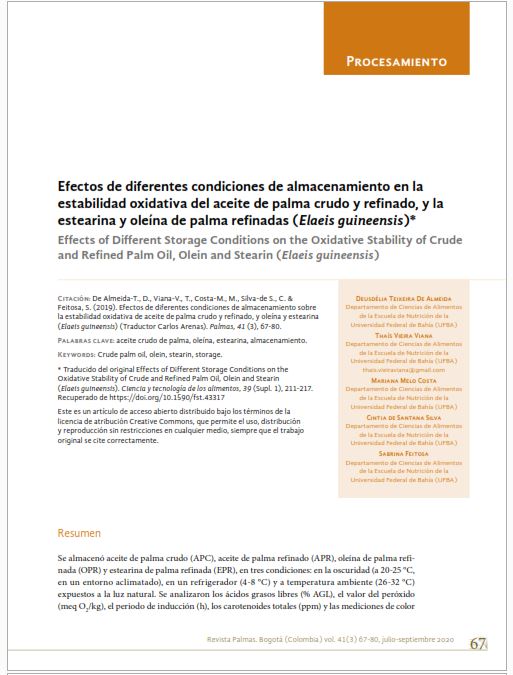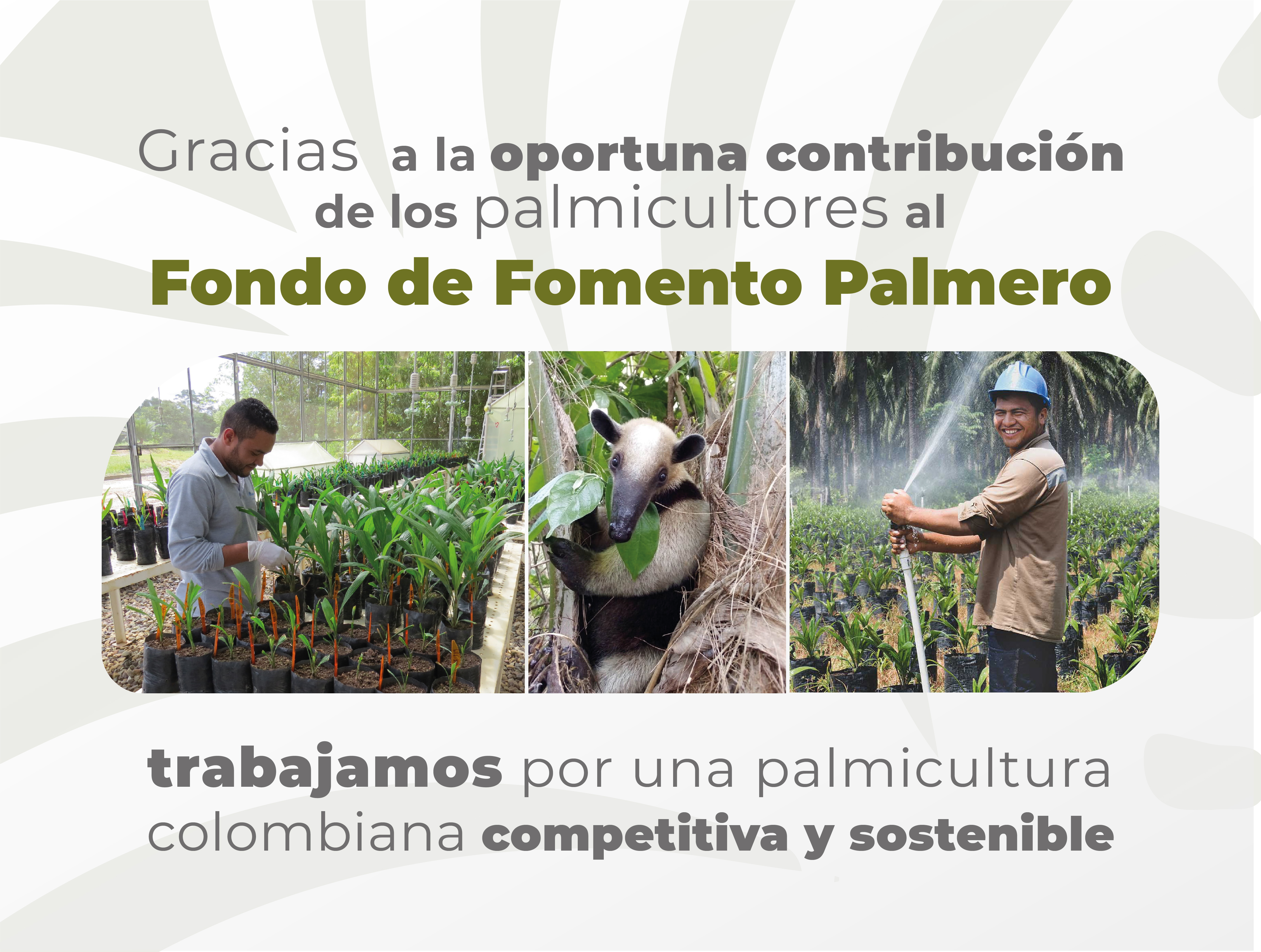Efectos de diferentes condiciones de almacenamiento en la estabilidad oxidativa del aceite de palma crudo y refinado, y la estearina y oleína de palma refinadas (Elaeis guineensis)*
Palabras clave:
aceite crudo de palma, oleína, estearina, almacenamientoResumen
Se almacenó aceite de palma crudo (APC), aceite de palma refinado (APR), oleína de palma refi- nada (OPR) y estearina de palma refinada (EPR), en tres condiciones: en la oscuridad (a 20-25 °C, en un entorno aclimatado), en un refrigerador (4-8 °C) y a temperatura ambiente (26-32 °C) expuestos a la luz natural. Se analizaron los ácidos grasos libres (% AGL), el valor del peróxido (meq O2/kg), el periodo de inducción (h), los carotenoides totales (ppm) y las mediciones de color (CIELab), para determinar la estabilidad de los aceites cada mes hasta los 12 meses. Todos los aceites crudos/ refinados iniciales eran de buena calidad, excepto por una muestra de APC. El almacenamiento a 26-35 °C y la exposición a la luz aceleraron las reacciones oxidativas. La vida útil estimada del APC, APR, OPR y EPR almacenados a 20-25 °C y en la oscuridad fue de aproximadamente de 6, 9, 9 y 12 meses, respectivamente. Se encontraron aceites de mejor calidad almacenados a 4-8 °C, en comparación con los conservados en otras condiciones.
Aplicación práctica: el estudio tiene influencia sobre las prácticas, tiempos y condiciones de almacena- miento, además de discutir los criterios más importantes para obtener productos de calidad. El aceite de palma es utilizado ampliamente debido a su alta estabilidad y por considerar su consumo de importancia cultural y para la salud pública.
Referencias bibliográficas
Ahmad, T., Atta, S., Zeb, A. & Gul, S. (2011). Effect of Saturation and Micro Nutritional Status on Stability of Dietary Oils under Photooxidative Stress Condition. Journal of the Chemical Society of Pakistan, 33, 343-350.
Akusu, M. D., Achinewhu, S. C. & Mitchell, J. (2000). Quality Attributes and Storage Stability of Locally and Mechanically Extracted Crude Palm Oils in Selected Communities in Rivers and Bayelsa States, Nigeria. Plant Foods for Human Nutrition (Dordrecht, Netherlands), 55(2), 119-126. Disponible en http://dx.doi.org/10.1023/A:1008197612350. PMid:10898481.
Almeida, D. T., Nunes, O. L., Conde, P. L., Rosa, R. P. S., Rogério, W. F. & Machado, E. R. (2013). A Quality Assessment of Crude Palm Oil Marketed in Bahia, Brazil. Grasas y Aceites, 64(4),
387-394. Disponible en http:// dx.doi.org/10.3989/gya.118412.
Almeida, D. T., Curvelo, F. M., Costa, M. M., Viana, T. V. & Lima, P. C. (2017). Oxidative Stability of Crude Palm Oil after Deep Frying Akara (Fried Bean Paste). Food Science and Technology (Campinas), 38(1), 142-147. Disponible en http://dx.doi.org/10.1590/1678-457x.02217.
American Dil Chemists’ Society (ADCS). (2003). Official Methods of Recommended Practices of the American Oil Chemists’ Society (Methods Ca 5a-40, ADCS, Cd 8b-90). Champaign: ADCS Press.
Andreu-Sevilla, A., Hartmann, A., Sayas, E., Burló-Carbonell, F., Delgado-Estrella, P., Valverde, J. M. & Carbonell-Barrachina, Á. A. (2008). Mathematical Quantification of Total Carotenoids in Sioma Oil Using Color Coordinates and Multiple Linear Regression During Deep-frying Simulations. European Food Research and Technology, 226(6), 1283-1291. Disponible en http://dx.doi.org/10.1007/s00217-007-0656-2.
Borsato, D., Maia, E. C. R., Dall’Antonia, L. H., Silva, H. C. & Pereira, J. L. (2012). Kinetics of Oxidation of Biodiesel from Soybean Oil Mixed with TBHQ: Determination of Storage Time. Quimica Nova, 35(4), 733-737. http://dx.doi.org/10.1590/S0100-40422012000400015.
Brasil, Ministério da Saúde, Agência Nacional de Vigilância Sanitária. (2005, Septiembre 22). Resolução-RDC nº 270, de 22 de setembro de 2005. Regulamento Técnico para Óleos Vegetais, Gorduras Vegetais e Creme Vegetal. Diário Oficial [da] República Federativa do Brasil. Disponible en http://www.anvisa.gov.br
Ceballos, C., Moyano, M. J., Vicario, O. S., Alba, J. & Heredia, F. J. (2003). Chromatic evolution of virgin olive oils submitted to an accelerated oxidation test. Journal of the American Oil Chemists’ Society, 80(3), 257-262. http://dx.doi.org/10.1007/s11746-003-0686-0.
Choe, E., & Min, D. B. (2006). Mechanisms and factors for edible oil oxidation. Food Science and Food Safety, 5(4), 169-186. http://dx.doi.org/10.1111/j.1541-4337.2006.00009.x.
Codex Alimentarius. (2013). Codex standard for named vegetable oils: Codex-Stan 210. Rome: FAD/WHD.
Edem, D. D. (2002). Palm oil: Biochemical, physiological, nutritional, hematological, and toxicological aspects: a review. Plant Foods for Human Nutrition (Dordrecht, Netherlands), 57(3-4), 319-341. http:// dx.doi.org/10.1023/A:1021828132707. PMid:12602939.
Farhoosh, R., Einafshar, S., & Sharayei, P. (2009). The effect of commercial refining steps on the rancidity measures of soybean and canola oils. Food Chemistry, 115(3), 933-938. http:// dx.doi.org/10.1016/j.foodchem.2009.01.035.
Frank, N. E. G., Albert, M. M. E., Laverdure, D. E. E., & Paul, K. (2011). Assessment of the quality of crude palm oil from smallholders in Cameroon. Journal of Stored Products and Postharvest Research, 2, 52-58.
Gee, P. T. (2007). Analytical characteristics of crude and refined palm oil and fractions. European Journal of Lipid Science and Technology, 109(4), 373-379. http://dx.doi. org/10.1002/ejlt.200600264.
Gunstone, F. D., & Lin, S. W. (2011). Vegetable oils in food technology: composition, properties and use. Palm Dil, p. 59-93. http://dx.doi. org/10.1002/9781444339925.
Läubli, M. W., & Bruttel, P. A. (1986). Determination of the oxidative stability of fats and oils: comparison between the active oxygen method (ADCS Cd 12-57) and the Rancimat method. Journal of the American Oil Chemists’ Society, 63(6), 792-795. http://dx.doi. org/10.1007/BF02541966.
Mba, D. O., Dumont, M. J., & Ngadi, M. (2015). Onfluence of palm oil, canola oil and blends on characteristics of fried plantain crisps. British Food Journal, 117(6), 1793-1807. http:// dx.doi.org/10.1108/ BFJ-04-2014-0155.
Nkpa, N. N., Dsanu, F. C., & Arowolo, T. A. (1990). Effect of packaging materials on storage stability of crude palm oil. Journal of the American Oil Chemists’ Society, 67(4), 259-263. http://dx.doi. org/10.1007/BF02540653.
Oil World. (2013). Tomado de http://www.oilworld.biz/app.php
Pristouri, G., Badeka, A., & Kontominas, M. G. (2010). Effect of packaging material headspace, oxygen and light transmission, temperature and storage time on quality characteristics of extra virgin olive oil. Food Control, 21(4), 412-418. http://dx.doi.org/10.1016/j. foodcont.2009.06.019.
Rodríguez-Amaya, D. B., & Kimura, M. (2004). Harvestplus handbook for carotenoid analysis (HarvestPlus Technical Monograph, No 2). Washington: Onternational Food Policy Research Onstitute (OFPRO).
Sambanthamurthi, R., Sundram, K., & Tan, Y. (2000). Chemistry and biochemistry of palm oil. Progress in Lipid Research, 39(6), 507-558. http://dx.doi.org/10.1016/S0163-7827(00)00015-
1. PMid:11106812.
Sikorska, E., Caponio, F., Bilancia, M., Summo, C., & Pasqualone, A. (2007). Changes in colour of extra-virgin olive oil during storage. Polish Journal of Food and Nutrition Sciences, 57, 495-498.
Silva, S. M., Sampaio, K. A., Ceriani, R., Verhé, R., Stevens, C., De Greyt, W., & Meirelles, A. J. A. (2014). Effect of type of bleaching earth on the final color of refined palm oil. Lebensmittel- Wissenschaft + Technologie, 59(2), 1258-1264. http://dx.doi.org/10.1016/j. lwt.2014.05.028.
Tagoe, S. M. A., Dickinson, M. J., & Apetorgbor, M. M. (2012). Factors influencing quality of palm oil produced at the cottage industry level in Ghana. International Food Research Journal, 19, 271-278.
Tan, C. H., Ariffin, A. A., Ghazali, H. M., Tan, C. P., Kuntom, A., & Choo, A. C. (2017). Changes in oxidation indices and minor components of low free fatty acid and freshly extracted crude palm oils under two different storage conditions. Journal of Food Science and Technology, 54(7), 1757-1764. http://dx.doi.org/10.1007/s13197017-2569-9. PMid:28720930.
Tan, Y. A., Low, K. W., Lee, C. K., & Low, K. S. (2010). Omaging technique for quantification of oil palm fruit ripeness and oil content. European Journal of Lipid Science and Technology, 112(8), 838-843. http:// dx.doi.org/10.1002/ejlt.201000020.
Villela, A. A., Jaccoud, D. A. B., Rosa, L. P., & Freitas, M. V. (2014). Status and prospects of oil palm in the Brazilian Amazon. Biomass and Bioenergy, 67, 270-278. http://dx.doi. org/10.1016/j.biombioe.2014.05.005.
Vincent,C.J.,Shamsudin,R.,&Baharuddin,A.S.(2014).Pre-treatmentof oilpalmfruits:areview. Journal of Food Engineering, 143, 123-131. http://dx.doi.org/10.1016/j.jfoodeng.2014.06.022.
Warner, K., & Nelsen, T. (1996). ADCS collaborative study on sensory and volatile compound analyses of vegetable oils. Journal of the American Oil Chemists’ Society, 73(2), 157-166. http://dx.doi. org/10.1007/BF02523889.
Zambiazi, R. C., & Zambiazi, M. (2000). Vegetableoil oxidation: effectof endogenous components. Boletim da Sociedade Brasileira de Ciência e Tecnologia de Alimento, 34, 22-32.
Cómo citar
Descargas

Descargas
Publicado
Número
Sección
Métricas
| Estadísticas de artículo | |
|---|---|
| Vistas de resúmenes | |
| Vistas de PDF | |
| Descargas de PDF | |
| Vistas de HTML | |
| Otras vistas | |














